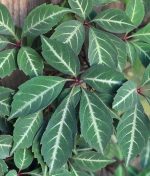 Also called Chinese Virginia creeper, this deciduous climber is native to China where it grows on moist rocks, clifts, and hillsides. It is a member of the grape family, Vitaceae, that also includes Boston ivy. Plants grow rapidly and may become 20-30′ long trailing along the ground or climbing on other plants or structures by means of strongly adhesive disks located at the end of the tendrils. The palmately compound leaves have 5-9 leaflets that are up to 5″ long and have conspicuous white veins. They are purplish green when they emerge, green tinged with bronze in the summer with maroon undersides, and bright orange, red and purplish in autumn. In spring inconspicuous clusters of greenish flowers appear and later give rise to fleshy black fruits that are attractive to birds. Although a vigorous plant, it has a more restrained growth than its relatives Virgina creeper and Boston ivy but offers attractive foliage in both spring, summer, and fall. It is a good choice for controlling soil erosion especially on hillsides, and growing in containers and on walls, trellises, arbors, other garden structures and unsightly objects. The genus name, Parthenocissus, comes from the Greek words, parthenos, meaning virgin, and kissos, meaning ivy, and refers to the first word of its English vernacular name, Virginia creeper, honoring Queen Elizabeth I who was known as the Virgin Queen. The specific epithet, henryana, honors Irish botanist and plant collector Augusting Henry (1857-1930) who discovered the species in central China in the 1880s.
Also called Chinese Virginia creeper, this deciduous climber is native to China where it grows on moist rocks, clifts, and hillsides. It is a member of the grape family, Vitaceae, that also includes Boston ivy. Plants grow rapidly and may become 20-30′ long trailing along the ground or climbing on other plants or structures by means of strongly adhesive disks located at the end of the tendrils. The palmately compound leaves have 5-9 leaflets that are up to 5″ long and have conspicuous white veins. They are purplish green when they emerge, green tinged with bronze in the summer with maroon undersides, and bright orange, red and purplish in autumn. In spring inconspicuous clusters of greenish flowers appear and later give rise to fleshy black fruits that are attractive to birds. Although a vigorous plant, it has a more restrained growth than its relatives Virgina creeper and Boston ivy but offers attractive foliage in both spring, summer, and fall. It is a good choice for controlling soil erosion especially on hillsides, and growing in containers and on walls, trellises, arbors, other garden structures and unsightly objects. The genus name, Parthenocissus, comes from the Greek words, parthenos, meaning virgin, and kissos, meaning ivy, and refers to the first word of its English vernacular name, Virginia creeper, honoring Queen Elizabeth I who was known as the Virgin Queen. The specific epithet, henryana, honors Irish botanist and plant collector Augusting Henry (1857-1930) who discovered the species in central China in the 1880s.
Type: Deciduous woody climber
Bloom: Inconspicuous greenish clusters of flowers in spring
Size: 20-30’H x 10-15′ W
Light: Full sun, partial shade; tolerates full shade but best color is in full sun
Soil: Average, medium moist, well-drained
Hardiness: Zones 8-9
Care: Prune in early winter; cut back in summer if needed
Pests and Diseases: None of significance
Propagation: Seed, layering, hardwood cuttings
Photo Credit: Rachida Boutboui Wikipedia